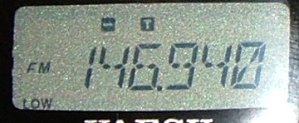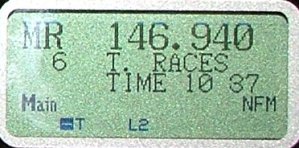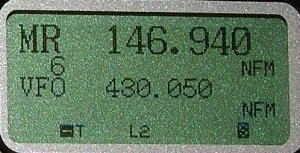Yaesu FT-60R vs Yaesu VX-7R
I’ve had a Yaesu FT-60R HT for about a year and a half now. While I did quite a bit of research before buying it, actually using it showed me where my research method was faulty. The radio itself is good, in that it does what it says it will and I’ve had no technical issues with it. It even survived a very heavy rain at the beginning of this month. The problem is that it’s damn complicated to operate. When I did the research I downloaded the manual and read a good portion of it, but the complication didn’t really show itself until I actually tried to use it.
The primary complication is that most of the keys perform three functions. The first function is on the key’s face and the second is marked above the key. The problem arises in the third function, which is not marked anywhere on the radio’s face. Consider the “1” key. Pressing “1” in VFO mode enters the digit. Pressing FW+1 enters “squelch type” selection mode (i.e. choose CTCSS, DCS, or none), and the text “SQ TYP” marked above the key at least helps you to remember the function. However, pressing and holding the 1 key activates weather band receive mode. There is no marking on the radio to indicate this. You have to read the manual and memorize this fact if you ever want to listen to the weather band.
Another member of our CERT just bought a Yaesu VX-7R to replace his previous radio which died after being exposed to a heavy rain. I played with it for a little while last Thursday night and was immediately struck by how much easier it is to use than my FT-60R. The “triple overload” (i.e. press-and-hold) options on the FT-60R have generally been moved to menus on the VX-7R and the use of press-and-hold is much more limited (i.e. pressing and holding the digit keys now results in the radio’s operating state being stored in the corresponding “hyper” memory location).
Most features and modes of the VX-7R can be accessed through the menus or shortcuts to submenus that are marked above the keys. For example, to enter menu mode, you press MonF and then 0, which has “SET” marked above it. Activating weather band receive mode is MonF+3 (3 has “WX” marked above it). This is far more intuitive that trying to remember that you have to press and hold “1” to get to the weather band. Setting the CTCSS mode and tones is done via MonF+8/TONE, which activates the submenu that is specific to tone encoding and squelch.
To get an idea of the difference in operation, consider trying to access a repeater at 146.94 that uses CTCSS encoding to activate the repeater (but which doesn’t send it on the repeater output) with a tone of 110.9. Both assume you’re in VFO mode to start (i.e. this isn’t already programmed in).
FT-60R:
- Enter repeater frequency (the radio will know it’s a repeater frequency and automatically determine the direction and offset, unless ARS has been disabled).
- Press FW, then press 1/SQ TYP.
- Rotate the selector knob until “TONE” is displayed.
- Press PTT to select.
- Press FW, then press 2/CODE.
- Rotate the selector knob until 110.9Hz appears.
- Press FW again to activate the tone (note inconsistent activation behavior between SQ TYP and TONE selection menus).
VX-7R:
- Enter repeater frequency (ARS, which is the default, will automatically set direction and offset).
- Press MonF+8/TONE to activate TSQ submenu.
- In menu item #1 (SQL TYPE), press MAIN/SUB until TONE appears.
- Rotate selection dial one step to get to menu item #2 (TONE SET).
- Press BAND key to activate value selection mode.
- Press MAIN/SUB until 110.9 appears.
- Press BAND to deactivate value selection mode.
- Press PTT to save and activate the settings.
The selection behavior is more consistent with the VX-7R in that MAIN/SUB are used as up/down buttons and BAND is used to activate entry/selection mode for certain submenus that have numeric or text settings (as opposed to those with discrete settings, like the SQL TYPE submenu above).
Another area where the VX-7R is superior is the size and resolution of the display. The FT-60R uses a segmented-style LCD with backlight, while the VX-7R uses a matrix-style LCD with backlight. The VX-7R can display icons as well as variable sized text. This allows for more expressive menu items, which makes them easier to understand. For example, when setting the lock mode on the FT-60R, you have to first select the LOCK menu item, then selecting “LK K+D” on the next screen means that the lock function locks out the keypad and the dial. On the VX-7R, the menu shows the full text “KEY+DIAL,” and fits everything onto one screen.
Here are a few screen shots for comparison. Sorry about the glare and fingerprints. It’s harder than it looks to get good pictures of shiny, curved, clear plastic items.
FT-60R in VFO mode:

VX-7R in memory mode with dual receive turned off (same repeater and settings, though):

VX-7R in dual receive mode:

So now I’m the owner of both an FT-60R and a VX-7R. I suppose that if I’d known at the time I bought the FT-60R what I now know about the VX-7R I would have probably bought the 7R. However, in favor of the FT-60R, it was about $200 less and the VX-7R had features I never thought I’d use or need (like 6m operation and submersibility). The price difference has changed since then, though, and the VX-7R is now only about $120 more than the FT-60R.
While I’m at it, I’d like to note the quick service of Austin Amateur Radio. I ordered the VX-7R last Friday morning, received a ship notification on Friday evening, and received the radio Monday afternoon.
 September 27, 2006
|
Posted by Aubrey Turner
September 27, 2006
|
Posted by Aubrey Turner
 Categories:
Categories:
Is there anyone who’s turned their PDF documentation into plain text? Quite useful for blind users where graphics are no substitute.
Your question got me curious about accessibility of PDF’s. It turns out that there are some guidelines for doing so, and the primary method is to use PDF tags. Unfortunately, the VX-7R’s manual isn’t tagged.
However, Acrobat Reader 7.0 has support for screen reading and will attempt to read the document to you even if it isn’t tagged.
It also had a feature to “Save as Text,” which I have tried. The output isn’t well formatted, since Yaesu relies a lot on tables in the manual. However, if you’re interested in taking a look at it, here’s a link to the file.
Yes, I did the same with Acrobat 7, but the tables are arranged in such a way so you don’t know where one column ends and the next begins in the text version. Also, did you look further down into the text to start reading how to actually operate the radio? All the key names are replaced with a space. Of course, if Yaesu had done their homework and prepared this thing correctly, all the key-press diagrams would have those tags of which you spoke and convert correctly. I think the only way to really do this right is to scan it and then see what happens. At least the scan will maintain the table properties and layout, and unless the type font used for the key names is something really off the wall, it should be better.